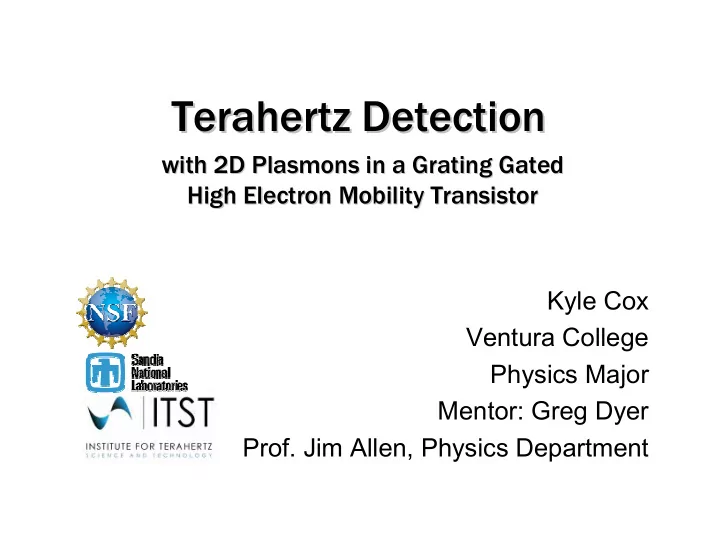

Terahertz Detection Terahertz Detection with 2D Plasmons in a Grating Gated with 2D Plasmons in a Grating Gated High Electron Mobility Transistor High Electron Mobility Transistor Kyle Cox Ventura College Physics Major Mentor: Greg Dyer Prof. Jim Allen, Physics Department
Why Terahertz? Why Terahertz? Terahertz (THz) Radiation Electromagnetic Spectrum • Electromagnetic Wave • ≈ 100GHz – 10THz Applications • Imaging like X-rays Terahertz Imaging • Medical and Security • >10,000x less energy than X-rays • Communications • Fast, short range • Outer space Picture (bottom) from http://optics.org/cws/article/research/9937/1/oleima3_99-02 Picture (top) from http://www.sp.phy.cam.ac.uk/SPWeb/research/thzcamera/WhatIsTHzImaging.htm
Research Objectives Research Objectives • Ultimate goal • Narrow band tunable terahertz detector • Bias a Transistor using LabVIEW • Recreate code with new equipment • Measure detector response • Bias a THz detector (without radiation) • Bias the detector with THz radiation (~140GHz )
Terahertz Detector Terahertz Detector • High Electron Mobility Transistor (HEMT) • Type of Field Effect Transistor (FET) • Control conductivity with electric field • Chemical make up (Epitaxial growth) • Quantum Well • creates 2 Dimensional Electron Gas (2DEG) • resonant excitation : 2D plasmon THz radiation • Low temperature (20K) • Our device is in the on state • Electrons are majority carrier S TG TG D BG TG Legend AlGaAs Source S 2DEG GaAs Barrier Gate BG AlGaAs Tuning Gate TG Drain D Not to scale
Terahertz Detector Terahertz Detector actually ≈ 250 TGs V BG V TG • 1x1mm Dimensions • BG controls conductivity • Bolometric Response S BG TG TG TG D • TG tunes resonance of 2D plasmon • Electron density (n) • Wave vector (k) 2µm V/I Source • Under constant current Legend • Plasmon should cause a Source S change in voltage Barrier Gate BG ∝ Tuning Gate TG f n k plasmon 2 D j Drain D
Experimental Set- -up up Experimental Set Ground Potentiometer BG TG V BG BG S TG TG TG D S D Potentiometer Oscilloscope Signal V TG Legend Source S Barrier Gate BG Tuning Gate TG Terahertz Keithley SourceMeter Drain D (I SD , V SD ) Source Trigger Pulse Generator Gunn Oscillator Some items have been omitted
Gate Bias without Radiation Gate Bias without Radiation Barrier Gate • Higher V BG limits current • Higher V BG means more voltage to achieve same current • Creates energy barrier that electrons must cross Tuning Gate • Verification of working gate • ~ 250 tuning gates act like a continuous gate
Raw Signal Data Raw Signal Data Barrier Gate Sweep • We convinced we are seeing a bolometric response because of signal after pinch off Tuning Gate Sweep • Electronic noise from the pulse generator
Initial Response Data Initial Response Data • No Signal until reaching pinch-off • Ideal barrier gate voltage around -500mV • No visible plasmon resonance • Polarity of the current • Built in values for device • Pinch-off and resonance may be hard to differentiate
Summary Summary • Learned how to code in LabVIEW • Integrated different instruments into experiment • Learned to bias a transistor • Saw terahertz detector working • Have yet to see plasmon resonance
Acknowledgements Acknowledgements • INSET • CNSI • Mentor: Greg Dyer • Faculty Advisor: Jim Allen • National Science Foundation (NSF) • Sandia National Laboratories • Institute of Terahertz Science and Technology(ITST)
Additional Info Additional Info
Experimental Setup Gunn Oscillator Layering Additional Terahertz Imaging
Recommend
More recommend